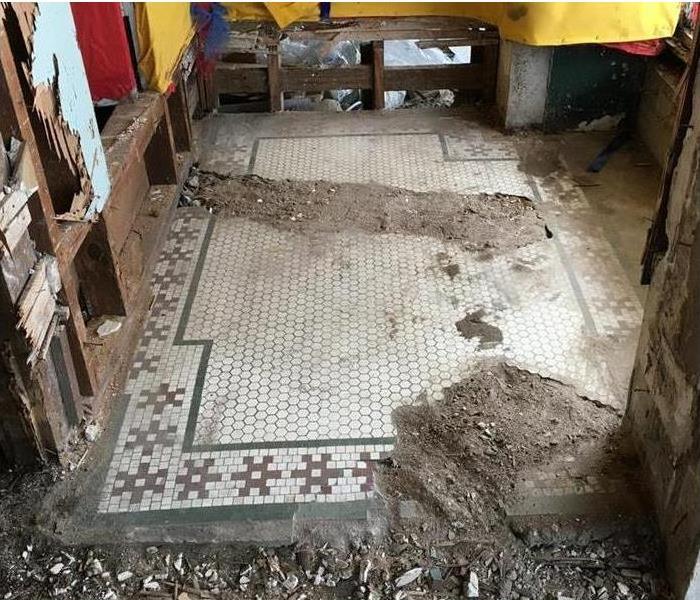What is a Large Loss?
7/6/2020 (Permalink)
A disaster has hit your home or business and left behind an excessive amount of damage. In the blink of an eye, you’ve lost your property and belongings. You’re also potentially looking at spending a large amount of money and time on repairs and renovations. Because of the extent of the damage, you will most likely be looking at a large-loss situation. But what exactly does that mean? What steps should you take to start putting your life back together? Fortunately, knowing what to expect and who to contact in a large-loss situation can help you wade through a lot of the unknown.
What is Large Loss?
For the most part, “large loss” is exactly what it sounds like. It’s any situation where there’s been a significant amount of damage to your property. For example, if a home has suffered a fire or several inches of flooding, the damage would most likely be extensive. There may be thousands of dollars worth of damage to the structure of the home and its contents. But determining whether damage constitutes as large loss is not just dependent on the amount of money involved, it varies per situation. Unfortunately, this means that there’s no set of rules or instructions to help you wade through it all. There are, however, several factors that can assist in determining whether or not your damage constitutes as large loss.
Damage can usually be considered a large loss when:
- A significant area or portion of a structure is damaged
- Damage results in a very complex set of repairs to restore things to their original state
- Most of the structure has to be replaced
- A large part of the business is put to a halt because of the damage
When you break it down, a large-loss project can be categorized by one or more of several different factors:
- The cost to restore the use of the structure to a “like new” condition
- The sheer size of a facility
- The specific use or purpose of a facility
While there is no structure or facility that is 100% safe from damage, some are definitely more time-consuming and pose more of a challenge to resolve.
Large Loss and Insurance
When disaster strikes, you need to know that your insurance company has your back. Being confident that you’re taken care of will help you begin the process of clean up, restoration and recovery. When it comes to insurance restoration, the extent of the damage to your structure will determine how your claim is handled and the steps you will need to take to move forward. You could be hit with the daunting task of renovating or rebuilding your property. In many cases, you may also have the added responsibility of replacing or salvaging things like documents, materials, equipment, or memorabilia. Regardless of what your situation looks like, it’s important to know just what your insurance policy covers.
What Will My Insurance Cover?
Before damage hits your home or business, it’s important to understand what your insurance policy does and does not cover. If you aren’t sure what you’re protected from, now might be a good time to call your insurance agent and find out!
Typically, your insurance policy pays to rebuild or repair your home or office building if it is ever damaged or destroyed by things like lightning, hail, a fire, a hurricane, or other disasters or accidents noted in your policy. Keep in mind, however, that many standard home insurance policies do not cover damage caused by an earthquake or flood. Knowing this ahead of time and having clarity on just what is included in your coverage could save you a huge headache in the event that you ever need to file a large loss claim.
What Should I Look For?
When searching for insurance coverage, your policy should cover the cost of clean up and repairs from natural disasters. It should also cover the cost of bringing your building up to code compliance. Remember, codes change over time. If your building was not in compliance at the time the damage occurred, you will want to make sure that gets addressed once you start repairing or rebuilding. Your policy may also cover additional living expenses. This includes things like renting an apartment or paying for your hotel stay while your home is under renovation. To make sure you’re well-covered, search for a policy that will pay to have your home rebuilt, if needed. The more protection you have, the better off you’ll be in the event of a disaster.
Single Structure Loss
Homeowners insurance coverage typically provides financial protection against damage or loss due to accidents, theft, and other disasters. This could include things like flooding and water damage, storm damage and electrical fires. When it comes to suffering large loss, you want to make sure you’re well-covered. We often use $50,000 as a break point of what really constitutes a large loss for a single structure. Other factors could be the number of affected floors of a multi-story building or the size and square footage of the facility itself.
Weather Disaster
A weather disaster that has destroyed multiple homes, communities, or even a large portion of a city or town is very clearly considered a large loss. Natural disasters such as hurricanes, floods, tornadoes and wildfires all tend to do an extensive amount of damage. Some of the more memorable natural disasters over the last few years have resulted in billions upon billions of dollars in damages:
- Colorado Wildfires
- Hurricane Harvey in Houston, Texas
- Hurricane Michael in the Florida Panhandle and the Gulf Coast
- Northern California Wildfires
- Hurricane Florence on the East Coast, specifically the Carolina's
- Southern California Wildfires
- Hurricane Irma in Florida, Puerto Rico, and Cuba
And so many more






 24/7 Emergency Service
24/7 Emergency Service
